Water Lane runs perpendicular to the western side of the High Street at it’s northern end and forms a junction only a few yards before the High Street joins Croft Lane. One of the oldest houses in the village is on this road; it has the date 1765 engraved in the plaster high up on its gable end.
“Holmside Cottage”, “The Old Cottage” and “The Black Swan” (c1905 onwards)
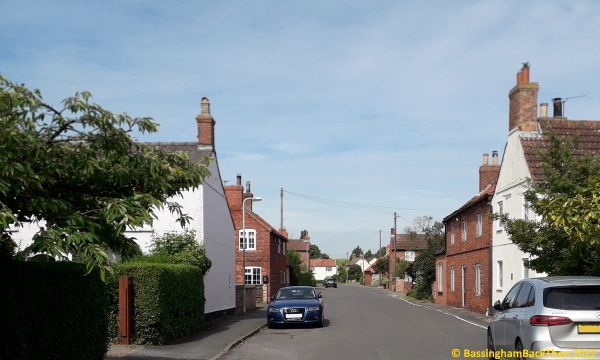 If you pushed me, I’d say that this is probably the earliest of the photographs that I currently have of Water Lane houses and “The Black Swan” public house. Possibly taken around 1905, it is complete with what looks like five young lads and a mother holding her baby with a carriage behind them. “The Black Swan” complete with its “Mucky Duck” sign is firmly in the foreground on the right. The building on the immediate right edge is a house which can be slightly more clearly seen on the next two postcards, between the pub and the line of cottages that stretch to the High Street; it has long since been pulled down. The gable-ended extension to the house in the middle of the photo is much clearer here. It looks as though it was built-on to the house immediately behind it. Over on the other side of the road, the house on the left perpendicular to the road is still there although it has now been rendered with white plaster. That building is now “Holmside Cottage”, 1 Water Lane. Immediately behind that is “The Old Cottage”, 3 Water Lane, with evidence of a shop front… The large, white gable-ended house in the centre distance is the one with the 1765 marking.
If you pushed me, I’d say that this is probably the earliest of the photographs that I currently have of Water Lane houses and “The Black Swan” public house. Possibly taken around 1905, it is complete with what looks like five young lads and a mother holding her baby with a carriage behind them. “The Black Swan” complete with its “Mucky Duck” sign is firmly in the foreground on the right. The building on the immediate right edge is a house which can be slightly more clearly seen on the next two postcards, between the pub and the line of cottages that stretch to the High Street; it has long since been pulled down. The gable-ended extension to the house in the middle of the photo is much clearer here. It looks as though it was built-on to the house immediately behind it. Over on the other side of the road, the house on the left perpendicular to the road is still there although it has now been rendered with white plaster. That building is now “Holmside Cottage”, 1 Water Lane. Immediately behind that is “The Old Cottage”, 3 Water Lane, with evidence of a shop front… The large, white gable-ended house in the centre distance is the one with the 1765 marking.
*The original of this photograph can be seen on the Dunholme Camera Club website.

 This postcard appears on page 66 of The Bassingham Story (Wilson, B. & C., and Ash, 2003) where it is dated 1908, so that’s good enough for me. Trees in the foreground nowadays obscure the house visible on the left – “Holmside Cottage”, 1 Water Lane – in the old photograph.
This postcard appears on page 66 of The Bassingham Story (Wilson, B. & C., and Ash, 2003) where it is dated 1908, so that’s good enough for me. Trees in the foreground nowadays obscure the house visible on the left – “Holmside Cottage”, 1 Water Lane – in the old photograph. Clearly the postcard was never posted, although a great deal has been written on the back! Underneath the printed text we can see “Begin hear [sic] to read”, so we will… “Dear Old chum, It is not what you expect it is what you get, This is Water Lane Bassingham, I just run up to see Molly and we are sitting against the fire and turning a few things over you know) She gets a bit lovesick sometimes when she is seeking Sall Thompson. Molly is cleaning the Bosses boots with a little spit and a brush. It is Sunday better the day better the deed don’t laugh, I shall think you a happy man when you get one on each knee, So now I must conclude with love from a Friend.” The somewhat cryptic text affords us no clue to any of the sender, the recipient.
Clearly the postcard was never posted, although a great deal has been written on the back! Underneath the printed text we can see “Begin hear [sic] to read”, so we will… “Dear Old chum, It is not what you expect it is what you get, This is Water Lane Bassingham, I just run up to see Molly and we are sitting against the fire and turning a few things over you know) She gets a bit lovesick sometimes when she is seeking Sall Thompson. Molly is cleaning the Bosses boots with a little spit and a brush. It is Sunday better the day better the deed don’t laugh, I shall think you a happy man when you get one on each knee, So now I must conclude with love from a Friend.” The somewhat cryptic text affords us no clue to any of the sender, the recipient.
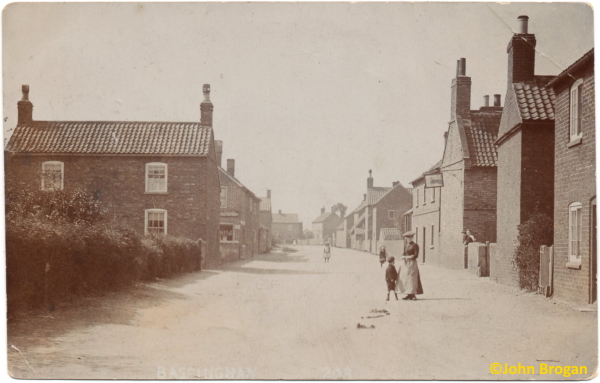
 John Brogan has kindly lent me this postally used card to show you. Dated 15th October 1911, it is pretty much the same view as before and on the left clearly shows a shop window in what is now “The Old Cottage” with the name M. Walker over the window. In the 1911 census Maurice Walker was a 33-years-old married “Grocer & General Dealer”, who was born in Brant Broughton and was now assisted in his duties by his 31-years-old wife, Gertrude.
John Brogan has kindly lent me this postally used card to show you. Dated 15th October 1911, it is pretty much the same view as before and on the left clearly shows a shop window in what is now “The Old Cottage” with the name M. Walker over the window. In the 1911 census Maurice Walker was a 33-years-old married “Grocer & General Dealer”, who was born in Brant Broughton and was now assisted in his duties by his 31-years-old wife, Gertrude. The message on the postcard, written from “Southfield” by Edgar Pilgrim to his London-based mother, reads: ” Dear Mother, I hope you are as well as I am. I know you are not having as good a time as I am. This is a photo of Mr Doulton’s public house, and is for Emmie. I am still yours, and always will be. The feast is at Bassingham. I love you as much as this xxx etc. I am still yours, Edgar xxx etc.” Arthur Harry Dalton (not Doulton) was a “Beer Housekeeper” in the 1911 census. Bizarrely, whilst “The Five Bells” and “The Bugle Horn” most certainly are, “The Black Swan” is never once referenced as a Public House in any census or Trades Directory that I have come across.
The message on the postcard, written from “Southfield” by Edgar Pilgrim to his London-based mother, reads: ” Dear Mother, I hope you are as well as I am. I know you are not having as good a time as I am. This is a photo of Mr Doulton’s public house, and is for Emmie. I am still yours, and always will be. The feast is at Bassingham. I love you as much as this xxx etc. I am still yours, Edgar xxx etc.” Arthur Harry Dalton (not Doulton) was a “Beer Housekeeper” in the 1911 census. Bizarrely, whilst “The Five Bells” and “The Bugle Horn” most certainly are, “The Black Swan” is never once referenced as a Public House in any census or Trades Directory that I have come across.

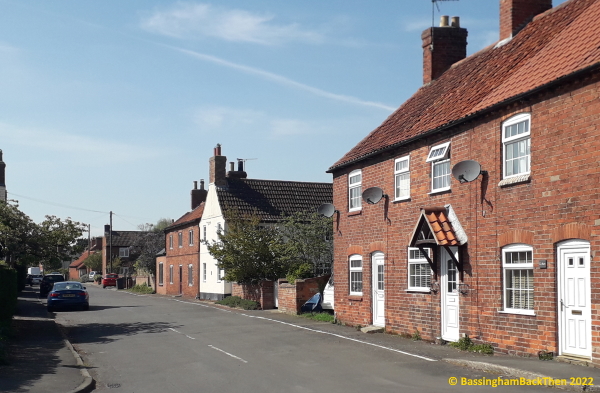 And then there is this postally used card which confirms a date of 5th July, 1921 although, of course, the postcard and actual photograph could date from several years beforehand. It is, nevertheless a very important image as it shows us that the first building of the row of terraced cottages nearest the camera was a shop complete with a proprietor and fittings for an awning. As you can see, the shop of the 1921 postcard is now one of three small terraced houses and is 2 Water Lane, named “Tŷ Bach”, which is Welsh for “small house” (which is also a euphemism for the toilet!) Next to it, and with a new door and the porch, is 4 Water Lane, and then 6 Water Lane at the end of the row. There also seems to have been a house demolished between this row of cottages and “The Black Swan”. The gable-ended building with a small upper window beyond the “Swan” has also been pulled down.
And then there is this postally used card which confirms a date of 5th July, 1921 although, of course, the postcard and actual photograph could date from several years beforehand. It is, nevertheless a very important image as it shows us that the first building of the row of terraced cottages nearest the camera was a shop complete with a proprietor and fittings for an awning. As you can see, the shop of the 1921 postcard is now one of three small terraced houses and is 2 Water Lane, named “Tŷ Bach”, which is Welsh for “small house” (which is also a euphemism for the toilet!) Next to it, and with a new door and the porch, is 4 Water Lane, and then 6 Water Lane at the end of the row. There also seems to have been a house demolished between this row of cottages and “The Black Swan”. The gable-ended building with a small upper window beyond the “Swan” has also been pulled down.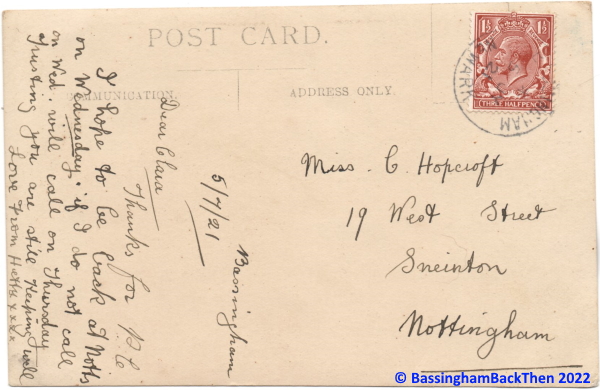 This is another of the postcards sent by an unknown “Hetty” to Miss Clara Hopcroft of 19 West Street, Sneinton, Nottingham. The text reads, “Bassingham 6/7/21 Dear Clara, Thanks for the P.C. [postcard] I hope to be back at Notts on Wednesday. If I do not call on Wed. will call on Thursday. Trusting you are still keeping well. Love from Hetty xxxx”
This is another of the postcards sent by an unknown “Hetty” to Miss Clara Hopcroft of 19 West Street, Sneinton, Nottingham. The text reads, “Bassingham 6/7/21 Dear Clara, Thanks for the P.C. [postcard] I hope to be back at Notts on Wednesday. If I do not call on Wed. will call on Thursday. Trusting you are still keeping well. Love from Hetty xxxx”
And finally… this one is a bit of a guess…
The Church from Water Lane? (undated)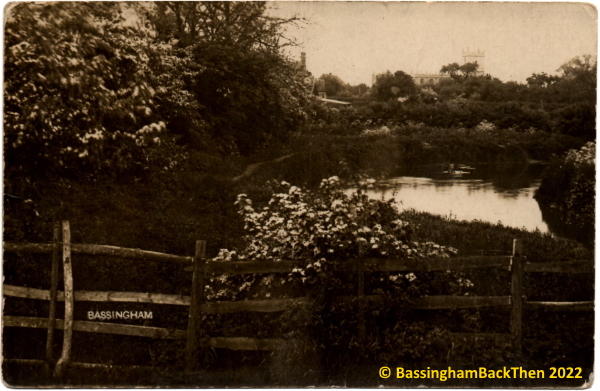 Although it doesn’t show any property on Water Lane, judging by the position of the church – we can see part of the Eastern side of the tower on this postcard – I am convinced that this romantic view was taken from somewhere down Water Lane. I originally thought that it might have been taken from Bassingham Road up at the top of the village, but I now think that might be too far away, and the bottom of Hall Wath is too close. I really do think that the photographer was standing somewhere around where the new houses are in Hall Field on the west side of Water Lane.
Although it doesn’t show any property on Water Lane, judging by the position of the church – we can see part of the Eastern side of the tower on this postcard – I am convinced that this romantic view was taken from somewhere down Water Lane. I originally thought that it might have been taken from Bassingham Road up at the top of the village, but I now think that might be too far away, and the bottom of Hall Wath is too close. I really do think that the photographer was standing somewhere around where the new houses are in Hall Field on the west side of Water Lane.

 BACK HOME
BACK HOME